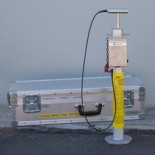 Impact Soil
Tester
Impact Soil
Tester 
|
|
|
Newsletter 15 Feburary 1995 TESTING OF GRAVEL AND CRUSHED ROCK ROADS WITH THE 20 KG CLEGG HAMMER The question has been asked - "Can the 20 kg Clegg Impact Soil Tester be of assistance in testing unbound pavements of such materials as naturally occurring gravels, crushed rocks, soft, rocks and weakly stabilised soils?" The 20 kg Heavy Hammer has a diameter of 130 mm compared with 50 mm for the Standard 4.5 kg Hammer. Pressure distribution concepts indicate that the larger diameter hammer will test to greater depth than the smaller one, typically not less than twice the diameter of the striking face. The resulting Impact Value (IV, or CIV for Clegg Impact Value) will be a function not only of the stiffness of the immediate surface but also of the composite effect of the underlying pavement layers. There are at least two possible areas of application that have been recognised. One involves estimating the pavement deflection under wheel loads and the other the variability of the paving material and its effect on maintenance requirements. A field correlation between CIV/H (Impact Value as applicable to the 20 kg Hammer) and Benkelman Beam deflections on lightly sealed pavements involving about 200 individual tests at six different location in Western Australia has indicated that the Benkelman Beam deflection may be estimated by an equation such as BB = 2.75 (CD) + 0.15 where BB is the rebound Benkelman Beam deflection in mm and CD is the deflection in mm calculated from CIV/H using double integration of time vs. deceleration. (For more information, refer to Technical Notes TN 1 & TN 2). Applying commonly used limits to Benkelman Beam deflection for low volume roads, e.g. 2.0 mm for 30 commercial vehicles per day, it is deduced that CIV/H of 28 is adequate for this traffic. For traffic of say 106 Equivalent Standard Axles (ESA) in the design life, the corresponding CIV/H is estimated as 44. Results from field observations on unsealed gravel roads in Western Australia and Indiana in the USA have indicated that the ratio of CHM/S divided by CHM/H reflects the structural condition of such pavements (where CHM/S = 0.088 (CIV)2 and CHM/H = 0.23 (CIV/H)2 with CHM standing for "Clegg Hammer Modulus" - see Newsletter 14). The actual CHM ratio values ranged from 0.75 to 2.33. Anecdotal evidence appears to support the notion that ratios higher than 1.0 are associated with pot-holing and rutting and that ratios lower than 1.0 are associated with corrugations (washboards). (Refer to Technical Note 2 of 1995, Version of July 2008, released by Dr Baden Clegg Pty Ltd for further information and table of data.) Note: the CHM ratio and values are the inverse of how previously presented in this Newsletter. From the foregoing it appears that the 20 kg Hammer should provide a simple low cost means of obtaining data for estimating traffic carrying potential of lightly surfaced low traffic volume roads. When using the 20 kg Hammer in conjunction with the 4.5 kg Hammer on unsealed roads, a better assessment of maintenance requirements looks possible and is worthy of consideration. For further discussion or technical information, please Contact Us |
|
|